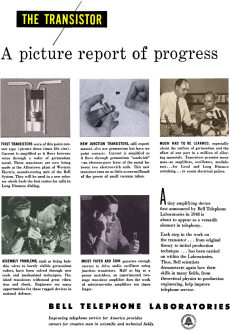|
June 1952 Radio-Electronics
 [Table of Contents] [Table of Contents]
Wax nostalgic about and learn from the history of early electronics.
See articles from Radio-Electronics,
published 1930-1988. All copyrights hereby acknowledged.
|
When this self-promotion
of progress made on the transistor invention by Bell Telephone Laboratories
appeared in the June 1952 issue of Radio-Electronics magazine, a mere
three and a half years had passed since the announcement of the achievement by
Drs. Bardeen, Brattain, and Shockley. Interestingly, it refers
to germanium as a metal rather than as a semiconductor. In that interim, many
problems had been solved in the effort to make robust, reproducible devices that
were affordable replacements for vacuum tubes. One of the primary differences
between the most recent transistors and the early models was the use of doped
junctions rather than point contacts. This made them more resistant to effects
of vibration, temperature changes, and contamination, and also produced higher
yields in manufacturing. Gaining the confidence of designers was imperative if
the newfangled technology was to gain (pun intended) ground as the preferred
component for amplifier, oscillator, mixer, and other type of circuits
traditionally served by tubes.
Bell Telephone Laboratories Ad
 The Transistor - A picture report of progress The Transistor - A picture report of progress
First Transistors were of this point contact type (picture
three times life size). Current is amplified as it flows between wires through a
wafer of germanium metal. These transistors are now being made at the Allentown
plant of Western Electric, manufacturing unit of the Bell System. They will be used
in a new selector which finds the best routes for calls in Long Distance dialing.
Assembly Problems, such as fixing hair-thin wires to barely
visible germanium wafers, have been solved through new tools and mechanized techniques.
Finished transistors withstand great vibration and shock. Engineers see many opportunities
for these rugged devices in national defense.
New Junction Transistors, still experimental, also use germanium
but have no point contacts. Current is amplified as it flows through germanium "sandwich"
- an electron-poor layer of the metal between two electron-rich ends. This new transistor
runs on as little as one-millionth of the power of small vacuum tubes.
Moist Paper and Coin generate enough current to drive audio
oscillator using junction transistors. Half as big as a penny matchbox, an experimental
two-stage transistor amplifier does the work of miniature-tube amplifiers ten times
larger.
Much to Be Learned, especially about the surface of germanium
and the effect of one part in a million of alloying materials. Transistors promise
many uses - as amplifiers, oscillators, modulators ... for Local and Long Distance
switching ... to count electrical pulses.
A tiny amplifying device first announced by Bell Telephone Laboratories in 1948
is about to appear as a versatile element in telephony.
Each step in the work on the transistor ... from original theory to initial production
technique ... has been carried on within the Laboratories. Thus, Bell scientists
demonstrate again how their skills in many fields, from theoretical physics to production
engineering, help improve telephone service.
Bell Telephone LaboratoriesImproving telephone service for America provides careers
for creative men in scientific and technical fields.
Posted June 14, 2022
| Bell Telephone
Laboratories Infomercials |
-
Bell Telephone Laboratories - Time Domain Reflectometry - December 1948 Popular
Science
-
The Future Holds Great Promise - August 1949 Popular Science
-
Waveguide: 7/47 Popular Mechanics
-
Wire Wrapping - 10/1953 Popular Science
-
X-Rays, 4/60 Radio-electronics
- The Battle of
the Atoms, 4/1948 Radio News
-
The Transistor, 6/1952 Radio-Electronics
- 90-Mile Laboratory
for Telephone and Television, 6/1945 Radio News
-
Wire-Wrap, 10/53 Radio-Electronics
-
EDT Crystals, 10/47 Radio-Craft
- Germanium Refining,
5/54 Radio & TV News
- Crystal Timekeeping,
1/46 Radio News
- Transatlantic
Cable, 11/56 Radio & Television News
- Pipe Circuits,
11/48 Radio & Television News
-
Coaxial
Electron Tube, 6/54 Radio & Television News
- Thermocompression
Wire Bonding, 3/58 Radio News
-
Radio Relay Stations, 8/52 Radio & Television News
- Isolators,
6/56 Radio & Television News
- Punch
Cards, 3/55 Radio & Television News
-
Over-the-Horizon
Communications, 10/55 Radio & Television News
- Memory
Devices, 2/58 Radio & TV News
-
Adventure in Silicon, 5/55 Radio & Television News
- Pipes of Progress,
6/55 Radio & Television News
-
Project Echo, 11/60 Electronics World
|
-
Testing Phones - November 1947 Popular Science
-
Jacques Bernoulli, February 1960 Radio-Electronics
-
Type-O Carrier System, October 1952 Radio-Electronics
-
Electron Microscope, 4/1952 Radio-Electronics
-
Thermistor, 11/1946 Radio-Craft
-
Germanium Crystal, 1/1954 Radio-Electronics
-
Lens
Antenna, 5/46 Radio-Craft
- Quality Control, 6/46
Radio News Article
- Transcontinental
Radio-Relay, 10/51 Radio & TV News
- Solar
Battery, 7/54 Radio & Television News
-
Germanium Transistors, 1/54 Radio & Television News
- Cavity
Magnetron, 10/45 Radio News
-
The Cableman, 10/49 Radio & Television News
-
Coaxial Cable, 12/49 Radio & Television News
-
Tin
Whiskers, 12/55 Radio & Television News
- Relay
Contact Inspection, 7/55 Radio & Television News
- Transistor's
10th Anniversary, 6/58 Radio & Television News
-
Wire
Wrapping, 10/53 Radio & Television News
- Junction
Diode Amplifier, 11/58 Radio News
-
Nobel Prize Winners, 2/57 Radio & Television News
-
Diode Speeds Voices, 8/58 Popular Electronics
-
Microwave Relays, 7/59 Electronics World
|
|





























